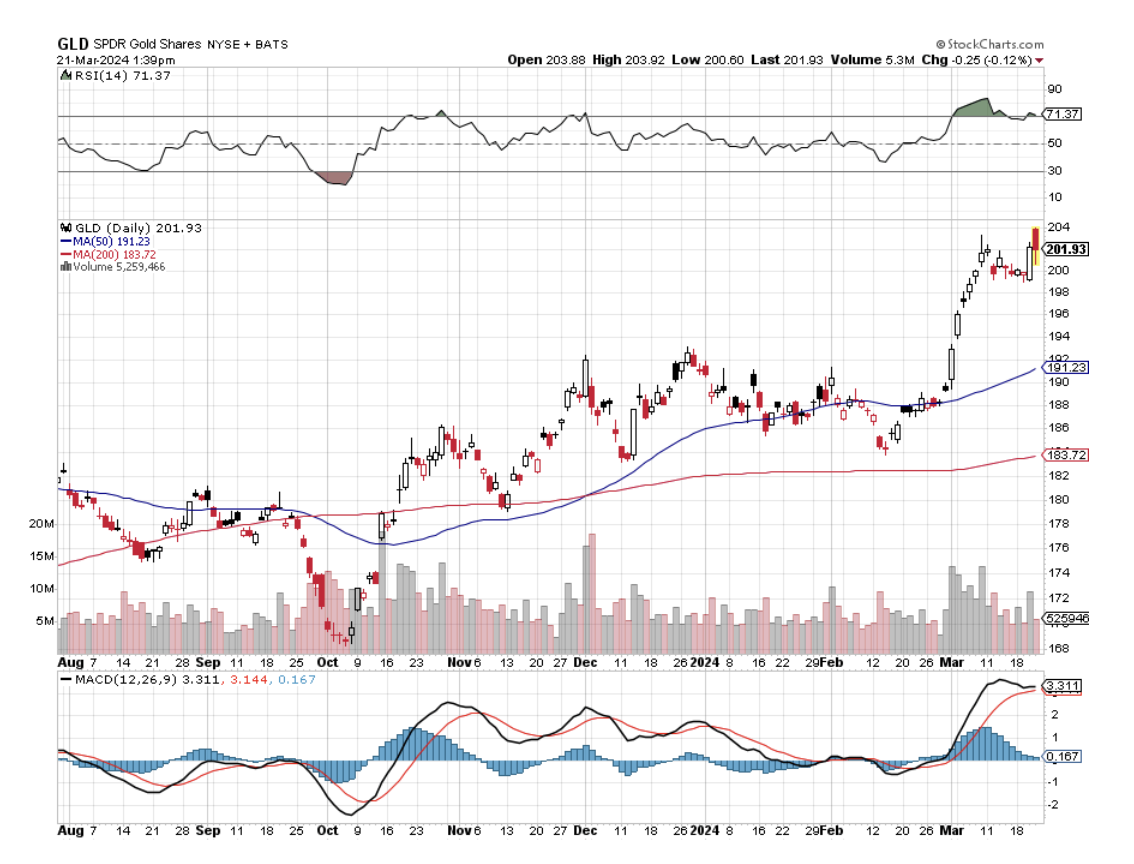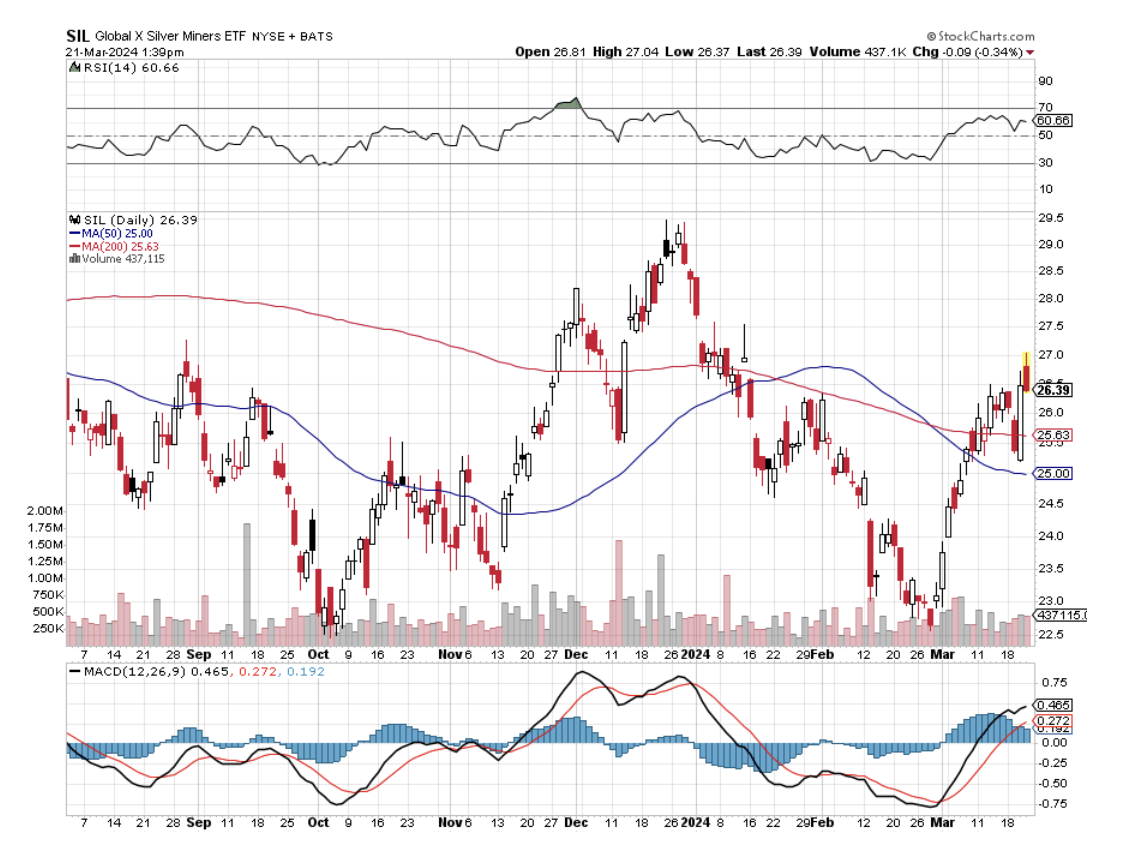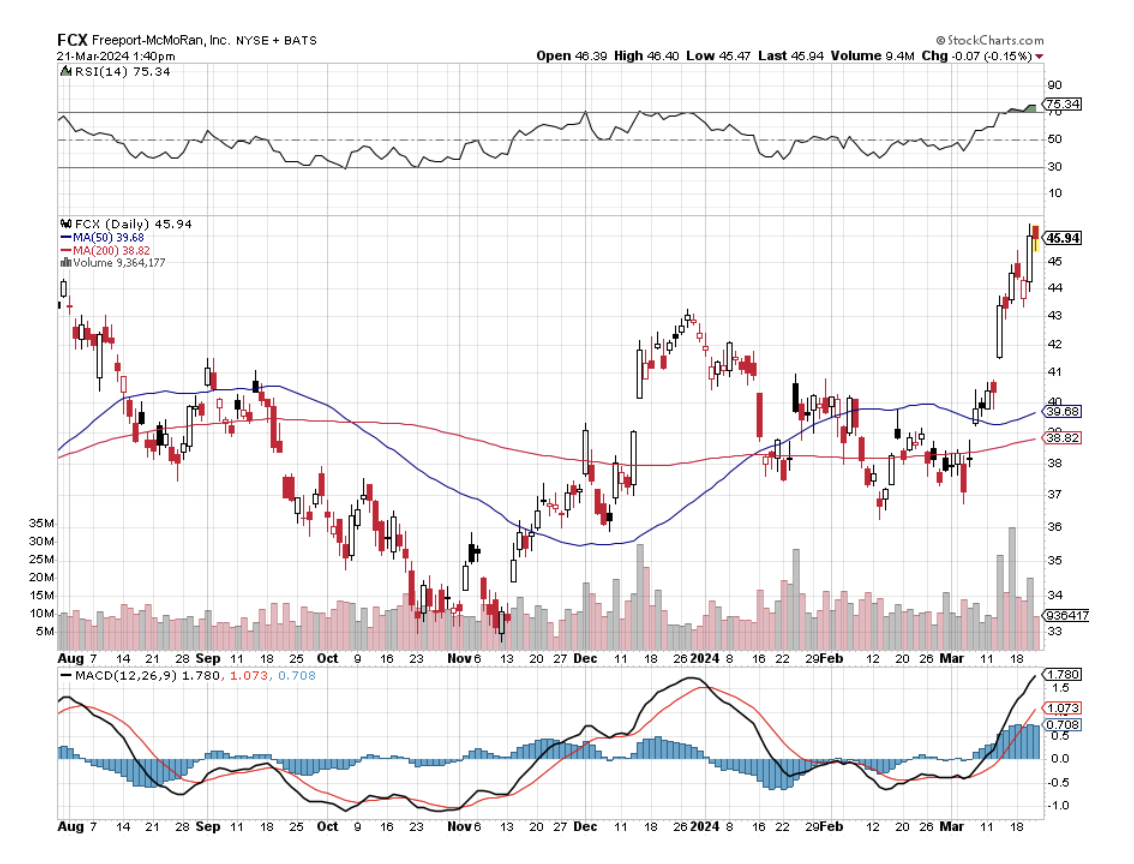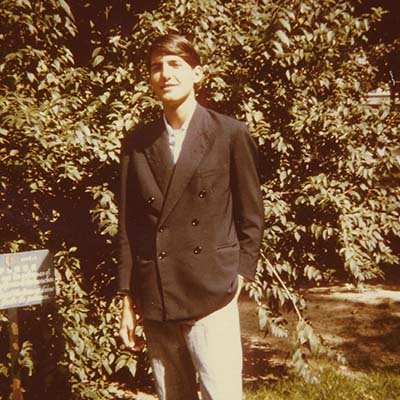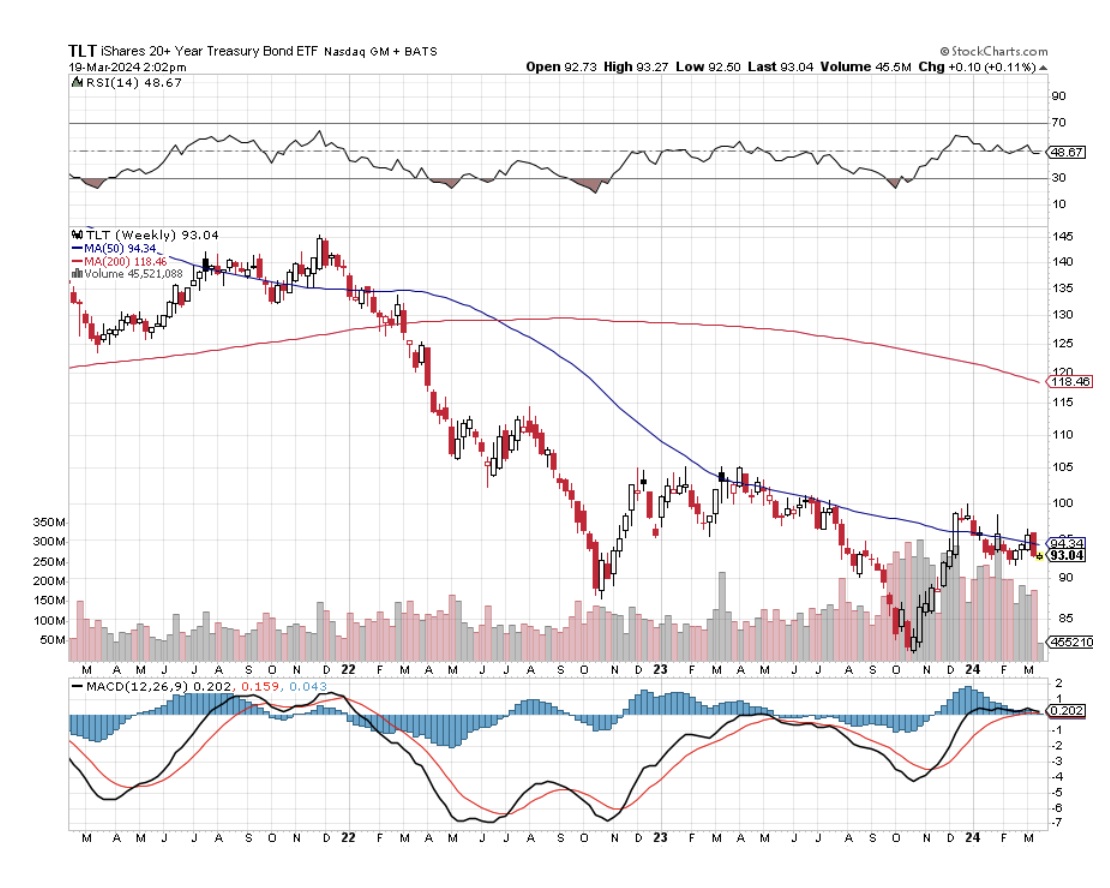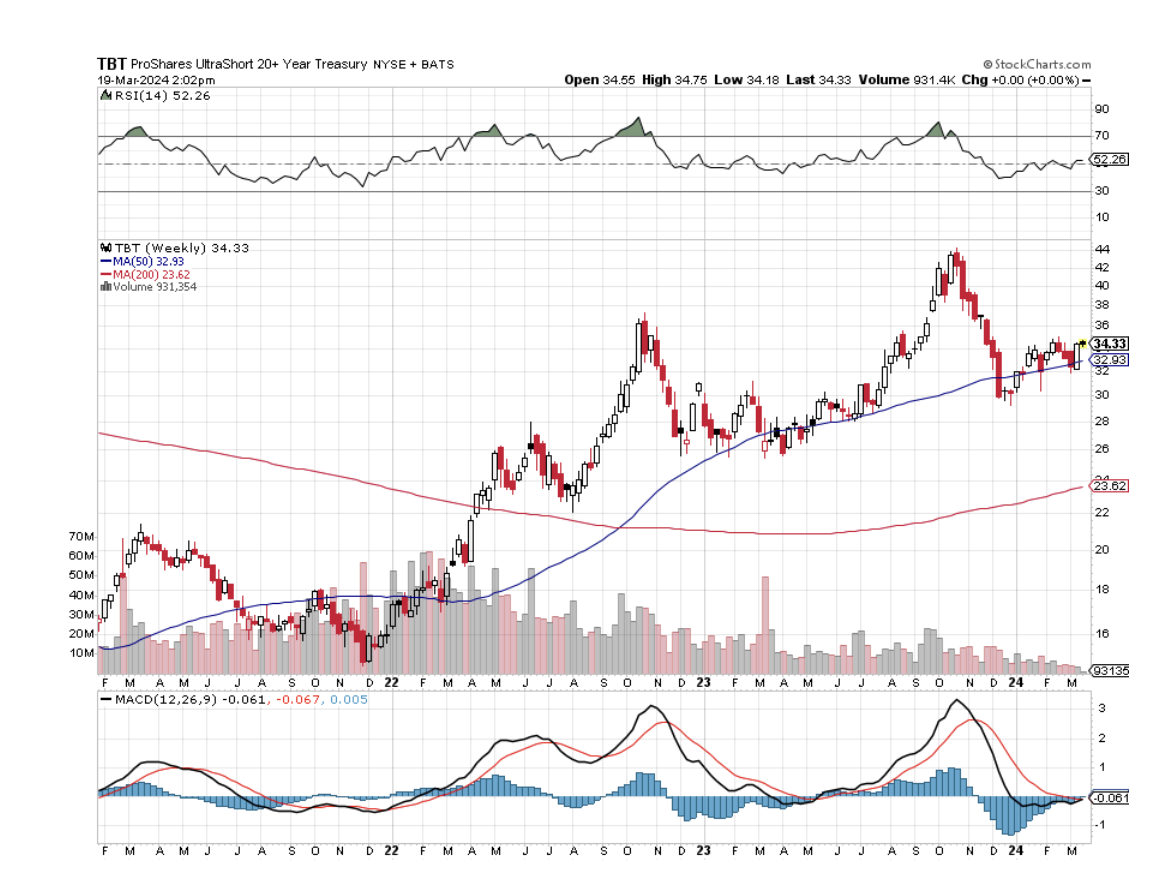
Global Market Comments
March 22, 2024
Fiat Lux
Featured Trade:
(MARCH 20 BIWEEKLY STRATEGY WEBINAR Q&A),
(DIS), (GLD), (BITB), (UUP), (FXY), (F), (TSLA), (NVDA), (FCX), (UNG), (TLT), (MCD)
Below please find subscribers’ Q&A for the March 20 Mad Hedge Fund Trader Global Strategy Webinar, broadcast from Silicon Valley.
Q: Do you recommend a form of dollar-cost averaging, and what is it?
A: Absolutely, yes. It is impossible for anybody to get an absolute bottom when you're buying, so the best thing to do is time average. If you have a position you like, go in there every day and buy a little piece. I bought Nvidia (NVDA) practically every day for months and boy did that work! (NVDA) had already gone up a lot, but I just kept buying it and buying it, averaging up and up. So that is the way I dollar-cost average. It's really more of a time averaging than a price averaging. No one knows where tops and bottoms are, even if they promise you that they do.
Q: Are you still long the Yen (FXY) and shorting the Dollar (UUP) given current conditions?
A: I actually don’t have any positions in the currencies, because the volatility is so low compared to stocks. Suffice to say that over time when US interest rates go down, currencies should go up, especially the Yen, which has been depressed for such a long time.
Q: Can gold (GLD) and Bitcoin (BITB) go up at the same time?
A: Absolutely. They almost always go up at the same time, because they are liquidity-driven assets, and when liquidity is as rich as it is now, all liquidity-driven assets go up at the same time which includes gold, silver, and Bitcoin and other cryptos. The only difference this time is that the source of liquidity is not the Federal Reserve—in fact, the Fed is quite restrictive right now with their high-interest rate policy—the new source of liquidity is corporate profits, especially from technology stocks, and that is unlimited and not subject to political whims. It’s always there and it’s always growing; it's a much better form of liquidity than the old form from the US government.
Q: What are your thoughts on the Disney (DIS) and Peltz fight, and how should that affect the stock price?
A: Whenever Nelson Peltz gets involved in a company, it's almost always positive for the stock even if he makes boards uncomfortable. That's why he's going in—to force better management. He usually succeeds and then gets out at a higher price. And if it means forcing some things on management they don't like (and I'm not really sure in the case of Disney what it is he's pressuring them for), he gets his profit and he leaves, and that's what corporate raiders do.
Q: Should I buy the dip in the EV narrative?
A: Not yet. You need a global economic recovery for that to happen, especially in Europe and China. We forget how prosperous we are here, and how weak things are in pretty much the rest of the world—and that is where the EV sales have really collapsed. So let the burden of proof be on the EV companies to report better sales and better technology, and then I'll be back in. Tesla periodically has 80% corrections: we’re right at the tail end of one of those. We may have another 10% to go and that's it. I'm a fair-weather friend, I only like to be long stocks when they're going up. How about that?
Q: I am understanding correctly that you believe the transition from technology and semiconductors to commodities and elsewhere is actually showing long-term strength growth for the tech stocks since they are mostly going sideways from here and not crashing with the rotation.
A: What I see is a time correction in technology where after tremendous moves they go sideways for a period, and new money switches over to other sectors like commodities and energy. And then you'll have a rotation back into technology after they've had a rest, probably before the end of the year. This back-and-forth kind of action could go on for many years—I've seen this happen before. So that's what I'm trying to position for now. And you know, I'm not alone in saying I don't like buying stocks after they tripled in a year. It's almost a no-win trade if you're a professional manager.
Q: Are we heading towards $90 a barrel in oil (USO), and will we pass $100?
A: Yes, we’re definitely headed to $90. But I think the new range is sort of like $65 to $95 because when you get up to the high prices, all of a sudden supply starts coming out of the woodwork, especially from the United States, which is already the world's largest oil producer at 13 million barrels a day. As soon as you get a high price, money just starts pouring in to start new drilling, setting up the next price collapse. The United States is the cap on global oil prices and China is the floor. They come in as the buyer of last resort as the world's largest consumer whenever prices get super cheap, and that actually is a best-case scenario—not only for us but for OPEC. Because their investments do well in the US when oil is in a $65 to $95 range. Any higher than that, the stock market crashes, wiping out the value of their savings. And that is how the modern world has evolved.
Q: Will today's Fed meeting be a non-event?
A: Yes, no interest rate changes until June, maybe even later. And the market is basically telling us that—dead in the water as it is. Dow is nowhere, and there are no big moves. Everyone is just treading water here.
Q: Would you take profits on NVIDIA (NVDA)?
A: Yes, some profits. I structured my own personal portfolio so I have expiring front month short put positions, which are ringing the cash register every month, but my long-term LEAPS I'm keeping. Because I think you could have another 50% move up in a year in (NVDA) stock given their dominant position in the market, and the fact that the new Blackwell chip, the $40,000 Blackwell chip is taking over the world. It's essentially a computer on its own, and it writes its own software. Nobody else is close to that, nor will they be. So keep the long-term positions to LEAPS, and keep taking profits every month. And you have to keep in mind also that (NVDA) is almost every portfolio manager's larger single position through capital appreciation, or they're not in it at all, and they're looking for a job or driving an Uber cab somewhere.
Q: Should I buy Ford (F) or Tesla (TSLA) or both?
A: Wait for the market to start discounting the Tesla Model 2 when it comes out next year. Maybe you start buying the stock in 6 months or a year. Probably the better question is not Ford or Tesla, but Tesla or Rivian (RIVN), which seems to be making progress in their mass production. I just don't see any future for the legacy car companies at all. They're just so far behind in technology. I spent most of my life trying to tell them what to do, and if they had followed my advice, they would be much better off than now.
Q: How long can an employment number stay strong? I feel like we have been waiting for a recession for almost 5 years now.
A: Actually the last real recession was the pandemic in 2020, which only lasted a couple of quarters. We may not have another real recession for 5 or 10 years. Why? Because we're in the roaring twenties and we have 6 more years to go. We also are in the new American Golden Age, and who's been predicting that for the last 10 years? I have! It's all about demographics. We happen to have peak spenders, i.e. people in their thirties and forties, at all-time highs, and that is what drives the economy—that is what makes the golden ages predictable as they have been for hundreds of years.
Q: How are the stem cell injections working?
A: Fantastic. After I got shot in the hip last year in Ukraine, I got one and I literally was walking around in weeks and eliminated the pain completely. I went from talking about hip replacement to climbing Kilimanjaro in literally a matter of weeks. So yes, they work for me. I know they don't work for everyone, but I've used them on both my knees, my back, and my hip, and they've been wildly successful. I won't need any more stem cell injections until I go back to Ukraine and get shot again.
Q: Where are you traveling to this time?
A: I’ll be working out of Florida during April, and probably take the quickie trip to Cuba. After that, it's Ecuador and the Galapagos Islands where I want to challenge Darwin’s Theory of Evolution. It turns out that it is in the same time zone as New York, so it'll be easy to work there from a time zone point of view. The Space X Starlink has provided great Internet everywhere, the Galapagos and Ukraine.
Q: Our real estate commission is about to disappear. Will that benefit housing prices?
A: You get what you pay for. If you have commissions drop from 6% to 1%, you'll get 1% worth of the service out of your agent. So if you want your house sold and sold well, you’d better keep paying the commission. Otherwise, your agent will not work for it. You get what you pay for. However, I always thought real estate commissions were too high for too long, and that may be about to change. And if you don't believe me, try selling your house on the internet someday. It doesn't work.
Q: Does the US have the infrastructure for electrification?
A: No, it does not. That means it has to be built out, and that is why we own Freeport McMoRan (FCX) and you should too! Anything involving electrification involves a lot of copper. The grid has to double in size to accommodate the needs of AI.
Q: Should I continue with natural gas (UNG)?
A: If you have a long-term position I would hang on because you're only one cold snap away from a major rally, and at some point, China will come back on stream as a major buyer. So long term I would hold it. Short term positions I would get rid of it before accelerated time decay wipes out your position.
Q: Will the US 10-year Treasury bond (TLT) go below 4% again?
A: Yes, when you get the Fed on an interest rate cutting cycle, 4% is easy; and by the way, home mortgages will be much cheaper in a year, so it's probably not a bad idea if you're buying a home now to take an adjustable-rate mortgage (ARM) then refinance after the Fed finishing cutting rates.
Q: Should I buy the dip in McDonald's (MCD)?
A: Probably not. The concern there is that the weight loss drugs are destroying American appetites and reducing their need for fast food. Eventually, some 100 million Americans could end up taking weight loss drugs. So that's why the stock is sold off. Fundamentally, (MCD) is a low-margin retail play so it's never interested me. The good news is that they're cutting jobs with computers. So that is the only reason to buy it, is the computerization effort. Walk into a new McDonald’s and you can only order by computer. The people there don’t even know how to take a verbal order. This is even more widespread in Europe where labor costs are higher.
To watch a replay of this webinar with all the charts, bells, whistles, and classic rock music, just log in to www.madhedgefundtrader.com, go to MY ACCOUNT, select your subscription (GLOBAL TRADING DISPATCH, TECHNOLOGY LETTER, or Jacquie's Post), then WEBINARS, and all the webinars from the last 12 years are there in all their glory.
Good Luck and Stay Healthy,
John Thomas
CEO & Publisher
The Diary of a Mad Hedge Fund Trader
Home Sweet Home
“If we’re in a bubble, then we’ll act bubbly,” said legendary hedge fund manager, David Tepper.
Global Market Comments
March 21, 2024
Fiat Lux
Featured Trade:
(REVISITING THE FIRST SILVER BUBBLE),
(SLV), (SLW)
Global Market Comments
March 20, 2024
Fiat Lux
Featured Trade:
(WELCOME TO THE DEFLATIONARY CENTURY),
(TLT), (TBT), (AAPL), (MSFT)
Ignore the lessons of history, and the cost to your portfolio will be great. Especially if you are a bond trader!
Meet deflation, upfront and ugly.
If you look at a chart for data from the United States consumer prices are rising at an annual 3.2% rate. The long-term average is 3.0%.
This is above the Federal Reserve’s own 2.0% annual inflation target, with most of the recent gains coming from housing costs.
We are not just having a deflationary year or decade. We may be having a deflationary century.
If so, it will not be the first one.
The 19th century saw continuously falling prices as well. Read the financial history of the United States, and it is beset with continuous stock market crashes, economic crises, and liquidity shortages.
The union movement sprung largely from the need to put a break on falling wages created by perennial labor oversupply and sub-living wages.
Enjoy riding the New York subway? Workers paid 10 cents an hour built it 125 years ago. It couldn’t be constructed today, as other more modern cities have discovered. The cost would be wildly prohibitive. Look no further than the California Bullet Train, now expected to cost $100 billion. A second transbay tube in San Francisco will cost $29 billion.
The causes of the 19th-century price collapse were easy to discern. A technology boom sparked an industrial revolution that reduced the labor content of end products by ten to a hundredfold.
Instead of employing 100 women for a day to make 100 spools of thread, a single man operating a machine could do the job in an hour.
The dramatic productivity gains swept through the developing economies like a hurricane. The jump from steam to electric power during the last quarter of the century took manufacturing gains a quantum leap forward.
If any of this sounds familiar, it is because we are now seeing a repeat of the exact same impact of accelerating technology. Machines and software are replacing human workers faster than their ability to retrain for new professions. If you want to order a Big Mac at McDonald’s these days, you need a PhD in Computer Science from MIT. The new stores have no humans to take orders.
This is why there has been no net gain in middle-class wages for the past 40 years. That is until the pandemic hit which created labor shortages that are still working their way out. It is the cause of the structurally high U-6 “discouraged workers” employment rate, as well as the millions of millennials still living in their parent’s basements.
To the above add the huge advances now being made in healthcare, biotechnology, genetic engineering, DNA-based computing, and big data solutions to problems. Did anyone say “AI”?
If all the major diseases in the world were wiped out, a probability within 10 years, how many healthcare jobs would that destroy?
Probably tens of millions.
So the deflation that we have been suffering in recent years isn’t likely to end any time soon. In fact, it is just getting started.
Why am I interested in this issue? Of course, I always enjoy analyzing and predicting the far future, using the unfolding of the last half-century as my guide. Then I have to live long enough to see if I’m right.
I did nail the rise of eight-track tapes over six-track ones, the victory of VHS over Betamax, the ascendance of Microsoft (MSFT) operating systems over OS2, and then the conquest of Apple (AAPL) over Motorola. So, I have a pretty good track record on this front.
For bond traders especially, there are far-reaching consequences of a deflationary century. It means that there will be no bond market crash, as many are predicting, just a slow grind up in long-term bond prices instead.
Amazingly, the top in rates in this cycle only reaches the bottom of past cycles at 5.49% for ten-year Treasury bonds (TLT), (TBT).
The soonest that we could possibly see real wage rises will be when a generational demographic labor shortage kicks in during the late 2020s.
I say this not as a casual observer, but as a trader who is constantly active in an entire range of debt instruments.
I just thought you’d like to know.
Hey, Have You Heard About John Deere?
Global Market Comments
March 19, 2024
Fiat Lux
Featured Trade:
(THE MAD HEDGE MARCH 12-14 TRADERS & INVESTORS SUMMIT VIDEOS ARE UP!)
(THE BEST COLLEGE GRADUATION GIFT EVER),
(TESTIMONIAL)
The Mad Hedge Summit Videos are Up, from the March 12-14 confab. Listen to 18 speakers opine on the best strategies, tactics, and instruments to use in these volatile markets. It is a true smorgasbord of investment strategies. Find the best one to suit your own goals.
The product discounts offered last week are still valid. Start, stop, and pause the videos at your leisure. Best of all, access to the videos is FREE. Access them all by going to www.madhedge.com, selecting CURRENT SUMMIT REPLAY, and clicking on WATCH REPLAY below the picture of your desired speaker.
There isn’t a man out there who doesn’t occasionally wish they could be 22 years old again but knows what they know now.
While it is unlikely that a time machine will be invented anytime soon for you to fulfill this wish, it is not impossible for a son, daughter, niece, nephew, or grandchild who recently graduated from college to achieve this.
A number of subscribers ever grateful for the trading and investment skills I have taught them over the past 16 years have asked me how they can pass this knowledge on to the next generation.
The answer is very simple. Set up a trading account in your child’s name and fund it with $10,000. Then buy them a one-year subscription to the Diary of a Mad Hedge Fund Trader.
Tell them that they get to keep any trading profits they generate. They can repay the original capital when they have the money to do so sometime in the future.
If they lose all the money, they get nothing more and the both of you have learned a valuable life lesson.
This happens to be how many Wall Street veterans teach their own kids how to trade. It is also how many major hedge fund managers started out. Nothing beats learning by doing.
Having watched followers do this for a decade, the stories that come back are nothing less than amazing. Some kids literally take to trading like a fish to water. They come up with trading ideas that are SO good that even I, a 55-year veteran, haven’t thought about them.
I have also seen the opposite extreme. Some nascent traders put all their money into a single ill-conceived trade and blow all the money in a matter of weeks (so you bought oil and the beginning of the Gulf War, not during the build-up?). They get discouraged and never trade again.
There is a good rule of thumb to follow here. The longer the student traders read the Diary of a Mad Hedge Fund Trader before committing to their first real money trade, the greater the likelihood of making a profit. Those who wait a year and paper trade with “play money” until then can be reliably expected to match or exceed my own 50%-60% annual returns.
If successful, the lessons learned are legion. They learn responsibility and how to accept the consequences of their own actions. There is NO arguing with a closing mark to market P&L in your trading account.
They also come to understand risk management, information flows, risk/reward, and the value of time spent on deep research. If they get drawn into reading books about trading or options so much the better. This is incredibly valuable information to have not only in investment but in any future business activity they may engage in.
Buy a man a fish and you feed him for a day. Teach him to fish and you feed him for life. This is a way to teach your young relatives how to fish so you can get yourself out of the fish-buying business.
The sooner you get kids out of the nest, the better.
Sometimes It Helps to Have Some Big Guns Behind You
Your background is very impressive and intriguing. You definitely have a lot of valuable and unique experience.
I read your most recent post on activist investing and couldn't agree more. I have always been a fan of activist strategies because even under an assumption of efficient markets, activism can still generate alpha in theory.
I have also heard about how process-oriented investments, such as activism or distressed investing where you have a greater influence over the final outcome, are valuable from a standpoint of downside protection.
Many thanks,
Andrew





